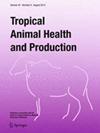Franciele Delevati de Oliveira, Natália Freddo, Natalie Renata Zorzi, Luciana Grazziotin Rossato Grando, Márcio Machado Costa, Wagner Antonio Tamagno, Maria Isabel Botelho Vieira
求助PDF
{"title":"Evaluation of clinical and hematological parameters in pregnant ewes naturally infected by Haemonchus contortus.","authors":"Franciele Delevati de Oliveira, Natália Freddo, Natalie Renata Zorzi, Luciana Grazziotin Rossato Grando, Márcio Machado Costa, Wagner Antonio Tamagno, Maria Isabel Botelho Vieira","doi":"10.1007/s11250-025-04513-5","DOIUrl":null,"url":null,"abstract":"<p><p>The present study aimed to evaluate the impact of natural infection by Haemonchus contortus in pregnant ewes. Clinical assessments were conducted using the FAMACHA<sup>©</sup> method, eggs per gram (EPG), and coproculture. Hematological and biochemical parameters, including cortisol levels, oxidative stress markers, hematocrit (HCT), and total plasma protein (TPP), were also analyzed. A total of 100 sheep naturally infected with H. contortus were used, 50 from the Corriedale breed and 50 from the Ile de France breed. Results indicated an increase in EPG (from 300 to 580 eggs by day 63). H. contortus was the predominant species identified in coproculture. Both breeds showed a proportional reduction in anemia severity as assessed by the FAMACHA© method throughout the experiment. HCT decreased near parturition, reaching 29% in both breeds, but increased by 0.09 units per day postpartum, reflecting physiological adaptations unrelated to parasitism. Hypoproteinemia (6.6 g/dL) was observed during the fourth sampling, coinciding with the rise in EPG. Higher serum cortisol levels were detected in non-anemic ewes (17.84 µg/dL) compared to anemic ones (10.19 µg/dL), particularly in the postpartum period. No significant changes were observed in oxidative stress markers. The study concluded that hypoproteinemia is associated with increased EPG. Even the highest EPG value of 580 eggs was not indicative of a severe parasitic infection. The HCT decreased proportionally between breeds over the course of the study, reaching its lowest value as parturition approached.</p>","PeriodicalId":23329,"journal":{"name":"Tropical animal health and production","volume":"57 5","pages":"251"},"PeriodicalIF":1.7000,"publicationDate":"2025-06-09","publicationTypes":"Journal Article","fieldsOfStudy":null,"isOpenAccess":false,"openAccessPdf":"","citationCount":"0","resultStr":null,"platform":"Semanticscholar","paperid":null,"PeriodicalName":"Tropical animal health and production","FirstCategoryId":"97","ListUrlMain":"https://doi.org/10.1007/s11250-025-04513-5","RegionNum":3,"RegionCategory":"农林科学","ArticlePicture":[],"TitleCN":null,"AbstractTextCN":null,"PMCID":null,"EPubDate":"","PubModel":"","JCR":"Q2","JCRName":"AGRICULTURE, DAIRY & ANIMAL SCIENCE","Score":null,"Total":0}
引用次数: 0
引用
批量引用
Abstract
The present study aimed to evaluate the impact of natural infection by Haemonchus contortus in pregnant ewes. Clinical assessments were conducted using the FAMACHA© method, eggs per gram (EPG), and coproculture. Hematological and biochemical parameters, including cortisol levels, oxidative stress markers, hematocrit (HCT), and total plasma protein (TPP), were also analyzed. A total of 100 sheep naturally infected with H. contortus were used, 50 from the Corriedale breed and 50 from the Ile de France breed. Results indicated an increase in EPG (from 300 to 580 eggs by day 63). H. contortus was the predominant species identified in coproculture. Both breeds showed a proportional reduction in anemia severity as assessed by the FAMACHA© method throughout the experiment. HCT decreased near parturition, reaching 29% in both breeds, but increased by 0.09 units per day postpartum, reflecting physiological adaptations unrelated to parasitism. Hypoproteinemia (6.6 g/dL) was observed during the fourth sampling, coinciding with the rise in EPG. Higher serum cortisol levels were detected in non-anemic ewes (17.84 µg/dL) compared to anemic ones (10.19 µg/dL), particularly in the postpartum period. No significant changes were observed in oxidative stress markers. The study concluded that hypoproteinemia is associated with increased EPG. Even the highest EPG value of 580 eggs was not indicative of a severe parasitic infection. The HCT decreased proportionally between breeds over the course of the study, reaching its lowest value as parturition approached.

 求助内容:
求助内容: 应助结果提醒方式:
应助结果提醒方式:


